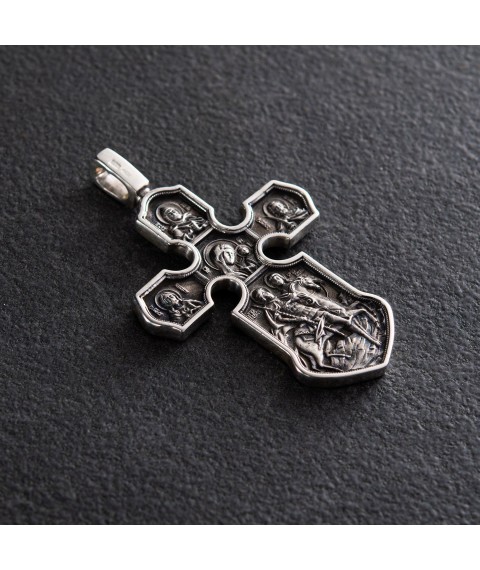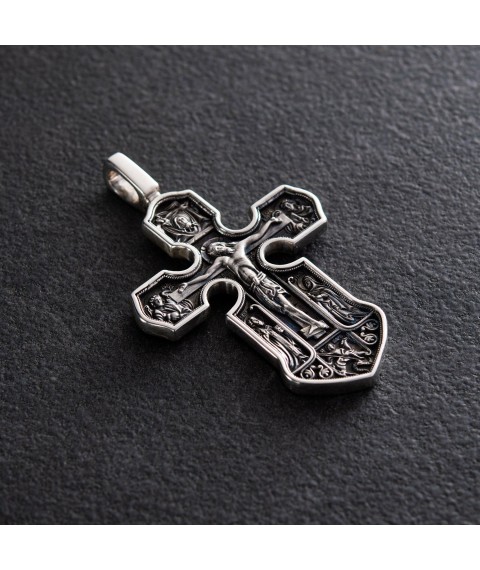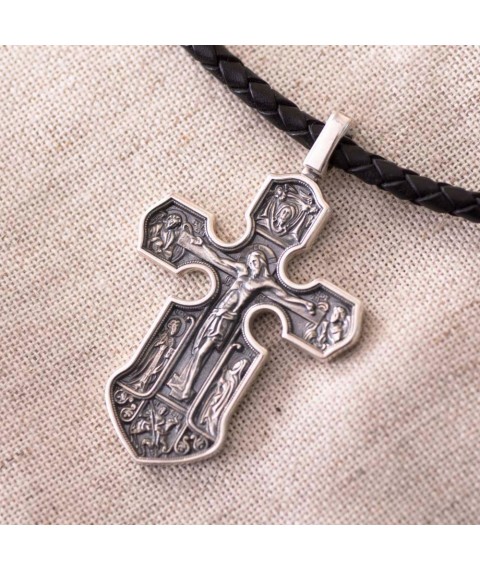Silver cross "Crucifixion. Kazan Icon of the Mother of God with the Saints Ahead"
Metal: silver 925"
Average weight: 14.2 g
A large pectoral cross, shaped like an anchor (the oldest image of the cross, a symbol of hope and salvation), is decorated with icons of Christ, the Mother of God and saints, famous for their fight against evil spirits, sorcerers, infidels and all evil in general.
On the front side, next to the Crucified Savior, stand the holy martyrs Cyprian and Justina. Before his baptism, the Holy Martyr Cyprian was a famous sorcerer, a servant of Satan and his favorite. One day Satan even sat him on his throne, put on a crown and promised to make him his prince after death. The cruelty and power of Cyprian terrified people, they feared him and worshiped him as a deity. But Satan, who gave the sorcerer the power to send illness and death, cause storms, and dry up the earth, turned out to be powerless before the meek Christian maiden Justina, who with fasting, prayer and the sign of the cross put an insurmountable barrier in front of the dark force. And a miracle happened - the great sorcerer believed in Christ, repented of his sins and entered into a terrible and painful battle with Satan. For this feat, the Lord granted the saint the grace to help people in the fight against the devil. Therefore, in moments of temptation and danger, the Church advises calling on the names of Saints Cyprian and Justina. Saint Cyprian subsequently became a priest and, together with Saint Justina, suffered martyrdom in 304 during the persecution of the Church under the Emperor Diocletian.
Standing next to the outstretched hands of the Crucified Christ are the holy archangels Michael (left) and Uriel, who have been given the power to help people in the fight against the spirits of evil. They strengthen our holy faith and enlighten our minds with the light of the Gospel. Archangel Michael is depicted with a sword in his hand. He is the military leader of the angelic army, who cast down from Heaven the rebel against God Dennitsa. Archangel Uriel has fire in his hand. He brings God's light to the world and rules over the heavenly bodies.
Above the Crucifixion is the image of the Savior Not Made by Hands. This is a board with the Face of Christ imprinted on it, which He handed to the artist and endowed with His healing power. Since ancient times, this image has been the main protective symbol in Christianity.
At the foot of the cross is depicted the most famous warrior-serpent fighter - the Great Martyr George the Victorious. The serpent in the Christian tradition symbolizes world evil, sin, the king of the Kingdom of Darkness, his princes and servants. Therefore, the victory of a Christian warrior over the serpent is not just a victory of a hero over a monster, but a triumph of the Church over the forces of evil. Saint George, who came to save the princess who was sacrificed to the snake, is a symbol of the salvation of the human soul from enslavement to sin and spiritual death.
Another serpent warrior is depicted on the back of the cross.
This is the Great Martyr Theodore Stratilates. Armed with a sword and prayer, he defeated the serpent that was devouring people and livestock in the vicinity of his hometown of Euchait. For his courage, Saint Theodore was appointed military commander (stratilate) in the city of Hercules, where he led many to the faith of Christ. The saint suffered martyrdom, being first crucified on the cross and then beheaded on February 21 (February 8), 319. With a raised sword, the Great Martyr Theodore is depicted to the right of the Kazan Icon of the Mother of God.
The Kazan icon is the central image of the reverse of the cross. This is one of the most revered icons of the Orthodox Church, a miraculous shrine of Russia, its shield against the invasion of enemies, a barrier from demons for every person.
To the left of the Kazan Icon is the image of the Great Martyr Nikita, called “besogon”, at the top is the image of the defender of the Russian land, Holy Prince Alexander Nevsky.
The martyr Nikita, the son of Tsar Maximian, was subjected to unimaginable torture by his father for becoming a Christian, and then imprisoned for three years. Here a demon appeared to the saint in the guise of an angel and tried to seduce him. But Nikita, having prayed, grabbed the demon by the hair, stepped on his neck and beat him with his chains. When the king again summoned him for questioning, the saint brought the demon with him by the hand and showed his father who was ruling over him. And so that his father would believe in Christ, Nikita resurrected two long-dead spouses. But nothing had any effect on Maximian. And then the whole city and the queen rebelled against him. On this day, Nikita baptized eighteen thousand four hundred people and soon rested in God. In his life it is said that he helps in teaching, heals, casts out demons, frees from slavery, helps to repent of sins and free oneself from the temptations of the devil.
Holy Blessed Prince Alexander Nevsky (1220-11/14/1263) - a great prayer warrior, ascetic and builder of the Russian land. In an era of difficult trials, he turned out to be the only Orthodox ruler not only in Rus', but throughout Europe, who did not compromise with the Catholic Church for the sake of maintaining power and defended Orthodoxy with the sword from the claims of the papal throne.
The lower part of the cross is occupied by icons of his holy ancestors, the passion-bearing princes Boris and Gleb, killed by his elder brother in 1015. Just 27 years after the Baptism of Rus', the holy brothers showed the Russians, accustomed to blood feud, that evil cannot be repaid with evil, even under the threat of death. “Whoever says: “I love God,” but hates his brother, is a liar.” (1 John 4:20), it is said in the Gospel. The holy martyrs Boris and Gleb gave their lives for the sake of observing the laws of love and obedience, on which the spiritual life of man and all life in society are based. Their blood became the basis of the unity of Rus', and they themselves became the defenders of its land and people.
This is the Great Martyr Theodore Stratilates. Armed with a sword and prayer, he defeated the serpent that was devouring people and livestock in the vicinity of his hometown of Euchait. For his courage, Saint Theodore was appointed military commander (stratilate) in the city of Hercules, where he led many to the faith of Christ. The saint suffered martyrdom, being first crucified on the cross and then beheaded on February 21 (February 8), 319. With a raised sword, the Great Martyr Theodore is depicted to the right of the Kazan Icon of the Mother of God.
The Kazan icon is the central image of the reverse of the cross. This is one of the most revered icons of the Orthodox Church, a miraculous shrine of Russia, its shield against the invasion of enemies, a barrier from demons for every person.
To the left of the Kazan Icon is the image of the Great Martyr Nikita, called “besogon”, at the top is the image of the defender of the Russian land, Holy Prince Alexander Nevsky.
The martyr Nikita, the son of Tsar Maximian, was subjected to unimaginable torture by his father for becoming a Christian, and then imprisoned for three years. Here a demon appeared to the saint in the guise of an angel and tried to seduce him. But Nikita, having prayed, grabbed the demon by the hair, stepped on his neck and beat him with his chains. When the king again summoned him for questioning, the saint brought the demon with him by the hand and showed his father who was ruling over him. And so that his father would believe in Christ, Nikita resurrected two long-dead spouses. But nothing had any effect on Maximian. And then the whole city and the queen rebelled against him. On this day, Nikita baptized eighteen thousand four hundred people and soon rested in God. In his life it is said that he helps in teaching, heals, casts out demons, frees from slavery, helps to repent of sins and free oneself from the temptations of the devil.
Holy Blessed Prince Alexander Nevsky (1220-11/14/1263) - a great prayer warrior, ascetic and builder of the Russian land. In an era of difficult trials, he turned out to be the only Orthodox ruler not only in Rus', but throughout Europe, who did not compromise with the Catholic Church for the sake of maintaining power and defended Orthodoxy with the sword from the claims of the papal throne.
The lower part of the cross is occupied by icons of his holy ancestors, the passion-bearing princes Boris and Gleb, killed by his elder brother in 1015. Just 27 years after the Baptism of Rus', the holy brothers showed the Russians, accustomed to blood feud, that evil cannot be repaid with evil, even under the threat of death. “Whoever says: “I love God,” but hates his brother, is a liar.” (1 John 4:20), it is said in the Gospel. The holy martyrs Boris and Gleb gave their lives for the sake of observing the laws of love and obedience, on which the spiritual life of man and all life in society are based. Their blood became the basis of the unity of Rus', and they themselves became the defenders of its land and people.
This is the Great Martyr Theodore Stratilates. Armed with a sword and prayer, he defeated the serpent that was devouring people and livestock in the vicinity of his hometown of Euchait. For his courage, Saint Theodore was appointed military commander (stratilate) in the city of Hercules, where he led many to the faith of Christ. The saint suffered martyrdom, being first crucified on the cross and then beheaded on February 21 (February 8), 319. With a raised sword, the Great Martyr Theodore is depicted to the right of the Kazan Icon of the Mother of God.
The Kazan icon is the central image of the reverse of the cross. This is one of the most revered icons of the Orthodox Church, a miraculous shrine of Russia, its shield against the invasion of enemies, a barrier from demons for every person.
To the left of the Kazan Icon is the image of the Great Martyr Nikita, called “besogon”, at the top is the image of the defender of the Russian land, Holy Prince Alexander Nevsky.
The martyr Nikita, the son of Tsar Maximian, was subjected to unimaginable torture by his father for becoming a Christian, and then imprisoned for three years. Here a demon appeared to the saint in the guise of an angel and tried to seduce him. But Nikita, having prayed, grabbed the demon by the hair, stepped on his neck and beat him with his chains. When the king again summoned him for questioning, the saint brought the demon with him by the hand and showed his father who was ruling over him. And so that his father would believe in Christ, Nikita resurrected two long-dead spouses. But nothing had any effect on Maximian. And then the whole city and the queen rebelled against him. On this day, Nikita baptized eighteen thousand four hundred people and soon rested in God. In his life it is said that he helps in teaching, heals, casts out demons, frees from slavery, helps to repent of sins and free oneself from the temptations of the devil.
Holy Blessed Prince Alexander Nevsky (1220-11/14/1263) - a great prayer warrior, ascetic and builder of the Russian land. In an era of difficult trials, he turned out to be the only Orthodox ruler not only in Rus', but throughout Europe, who did not compromise with the Catholic Church for the sake of maintaining power and defended Orthodoxy with the sword from the claims of the papal throne.
The lower part of the cross is occupied by icons of his holy ancestors, the passion-bearing princes Boris and Gleb, killed by his elder brother in 1015. Just 27 years after the Baptism of Rus', the holy brothers showed the Russians, accustomed to blood feud, that evil cannot be repaid with evil, even under the threat of death. “Whoever says: “I love God,” but hates his brother, is a liar.” (1 John 4:20), it is said in the Gospel. The holy martyrs Boris and Gleb gave their lives for the sake of observing the laws of love and obedience, on which the spiritual life of man and all life in society are based. Their blood became the basis of the unity of Rus', and they themselves became the defenders of its land and people.
devouring people and livestock in the vicinity of his hometown of Evkhait. For his courage, Saint Theodore was appointed military commander (stratilate) in the city of Hercules, where he led many to the faith of Christ. The saint suffered martyrdom, being first crucified on the cross and then beheaded on February 21 (February 8), 319. With a raised sword, the Great Martyr Theodore is depicted to the right of the Kazan Icon of the Mother of God.
The Kazan icon is the central image of the reverse of the cross. This is one of the most revered icons of the Orthodox Church, a miraculous shrine of Russia, its shield against the invasion of enemies, a barrier from demons for every person.
To the left of the Kazan Icon is the image of the Great Martyr Nikita, called “besogon”, at the top is the image of the defender of the Russian land, Holy Prince Alexander Nevsky.
The martyr Nikita, the son of Tsar Maximian, was subjected to unimaginable torture by his father for becoming a Christian, and then imprisoned for three years. Here a demon appeared to the saint in the guise of an angel and tried to seduce him. But Nikita, having prayed, grabbed the demon by the hair, stepped on his neck and beat him with his chains. When the king again summoned him for questioning, the saint brought the demon with him by the hand and showed his father who was ruling over him. And so that his father would believe in Christ, Nikita resurrected two long-dead spouses. But nothing had any effect on Maximian. And then the whole city and the queen rebelled against him. On this day, Nikita baptized eighteen thousand four hundred people and soon rested in God. In his life it is said that he helps in teaching, heals, casts out demons, frees from slavery, helps to repent of sins and free oneself from the temptations of the devil.
Holy Blessed Prince Alexander Nevsky (1220-11/14/1263) - a great prayer warrior, ascetic and builder of the Russian land. In an era of difficult trials, he turned out to be the only Orthodox ruler not only in Rus', but throughout Europe, who did not compromise with the Catholic Church for the sake of maintaining power and defended Orthodoxy with the sword from the claims of the papal throne.
The lower part of the cross is occupied by icons of his holy ancestors, the passion-bearing princes Boris and Gleb, killed by his elder brother in 1015. Just 27 years after the Baptism of Rus', the holy brothers showed the Russians, accustomed to blood feud, that evil cannot be repaid with evil, even under the threat of death. “Whoever says: “I love God,” but hates his brother, is a liar.” (1 John 4:20), it is said in the Gospel. The holy martyrs Boris and Gleb gave their lives for the sake of observing the laws of love and obedience, on which the spiritual life of man and all life in society are based. Their blood became the basis of the unity of Rus', and they themselves became the defenders of its land and people.






